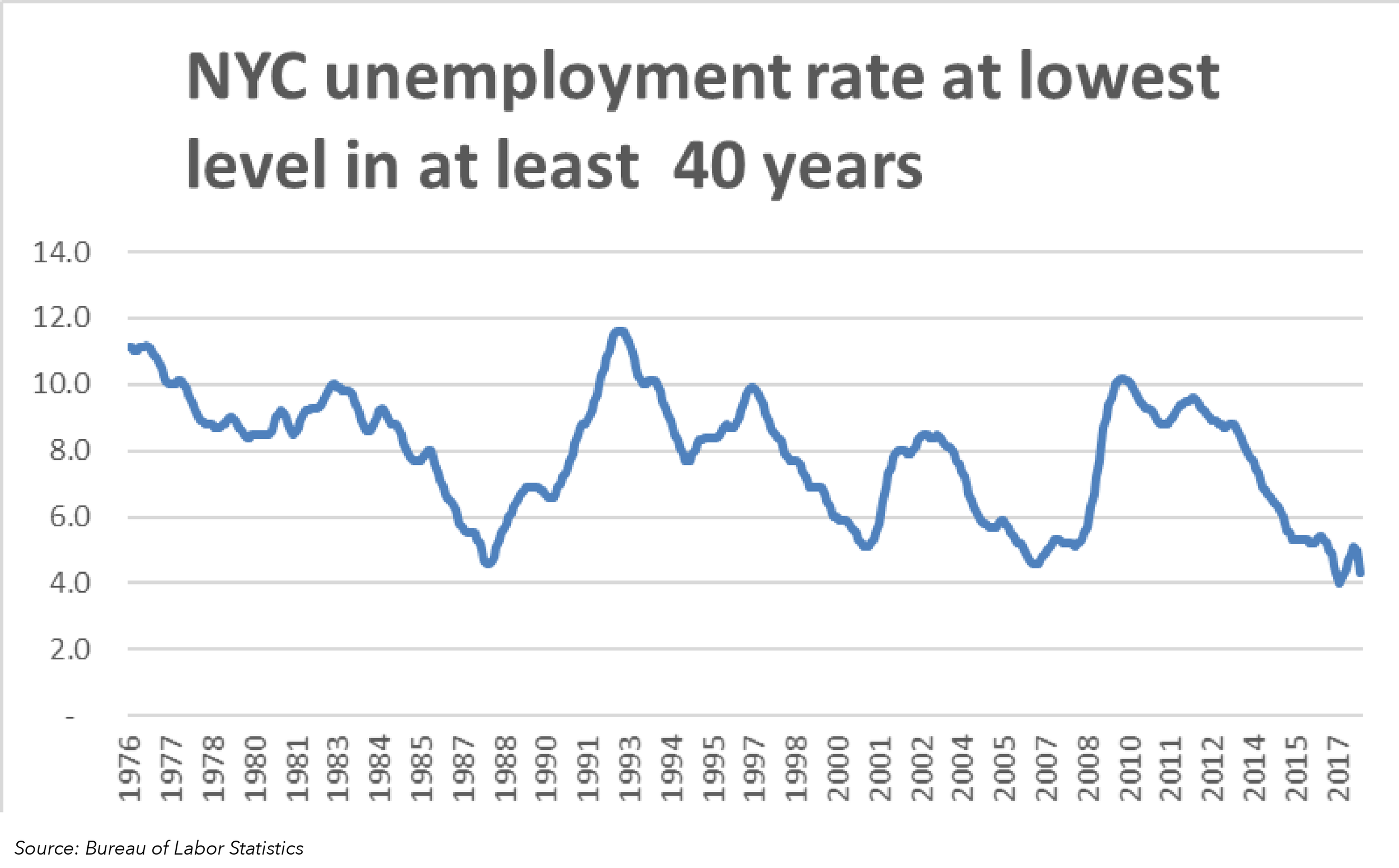February 28, 2018
A Rising Employment Rate Means Fewer Sidelined Workers
By James A. Parrott, PhD
Economic theory suggests that sustained periods of low unemployment should produce an array of broadly enjoyed job market benefits. Not only will more people have jobs: their wages should also rise; overall poverty should subside; and general economic conditions for the traditionally disadvantaged should improve.
Unfortunately, reality doesn’t always conform to theory quite so neatly or favorably. But in New York City today, a nearly decade-long rising economic tide – the steady recovery the city has seen since the 2008-09 Great Recession – really is starting to lift all boats. It’s a stars-aligning moment with important implications for, among other issues, the debate about the effects of New York State’s rising minimum wage levels.
First, let’s look at the facts, starting with the city’s current historically low unemployment rates. In the 40-year history of the local unemployment rate, the last two years has been the longest stretch of sub-5% unemployment.
Another way to measure the recovery’s effect on local workers is by using the employment, not unemployment, rate. In many parts of the nation, the recovery has been far more modest than in New York City. Many long-jobless workers have dropped out of the labor force altogether because of bleak re-employment prospects. This has led many observers to suggest that the employment rate, which measures the percentage of people 16 and older with jobs, rather than the unemployment rate, which doesn’t include those who’ve stopped looking for work, paints a truer picture of job market health. Our analysis shows what has happened to the employment rate in this recovery/expansion, and how New York City’s trend compares with that of the nation as a whole.
The solid line in the chart below shows the employment rate trend for the U.S. It indicates that while the employment rate has been rising steadily since 2010, it is still not quite back to the pre-Great Recession level of 2006 or 2007. (To adjust for the baby boom generation, many of whom have begun to retire, we show an “age-adjusted” employment rate with population weights for three age groups: under 25; 25-54; and 55 and older, all held constant since 2000.)
On the other hand, New York City’s employment rate (for city residents, dashed line in the chart), is now nearly two percentage points above its pre-Recession peak. That provides another data point favoring the conclusion that the recovery here has been stronger than in much of the country.
Though the gap has narrowed considerably in recent years, however, why does New York City’s employment rate still lag the nation’s by more than three percentage points? Economists generally say it’s because the city’s 16-and-over population is less White than in the nation overall. Blacks and Latinos usually have lower employment rates than Whites, with lower levels of educational attainment and the impact of racial discrimination in hiring two major explanatory factors.
But even here, there’s evidence of welcome progress. A tighter job market is providing greater opportunity for those traditionally considered to be at the end of the employment queue. That includes, for example, men and women with criminal justice records, as a recent New York Times article headlined “As Labor Pool Shrinks, Prison Time Is Less of a Hiring Hurdle” pointed out.
This chart shows that New York City’s young workers and less-educated workers have indeed seen faster employment rate gains over the past five years. For example, the employment rate for those 20-24 years of age increased from 42% in 2012 to nearly 50% in 2017, a greater gain than the rise from 71% to 76% for workers 25-54 (the years considered “prime working age”).
This strongly rising employment rate for young workers should help allay the concerns expressed by some that New York State’s phased-in $15 minimum wage might significantly reduce job opportunities for young workers and others traditionally at the end of the job queue. In 2013, New York’s minimum wage was the same as the $7.25-an-hour federal minimum. Today, the state minimum wage for New York City fast-food employers is $13.50; for businesses with 11 or more employees it is $13.00; and for employers with 10 or fewer workers it is $12.00. Employment rates for New York City’s young workers and less-educated workers have steadily climbed as the minimum wage has increased. Moreover, the employment rate for workers in New York City with less than a high school diploma rose by twice as much as in the nation overall over the past five years -- years when the minimum wage remained at the federally set $7.25 in 20 states, and when increases in the wage floor in the other states (except for California) have been less than in New York City.





